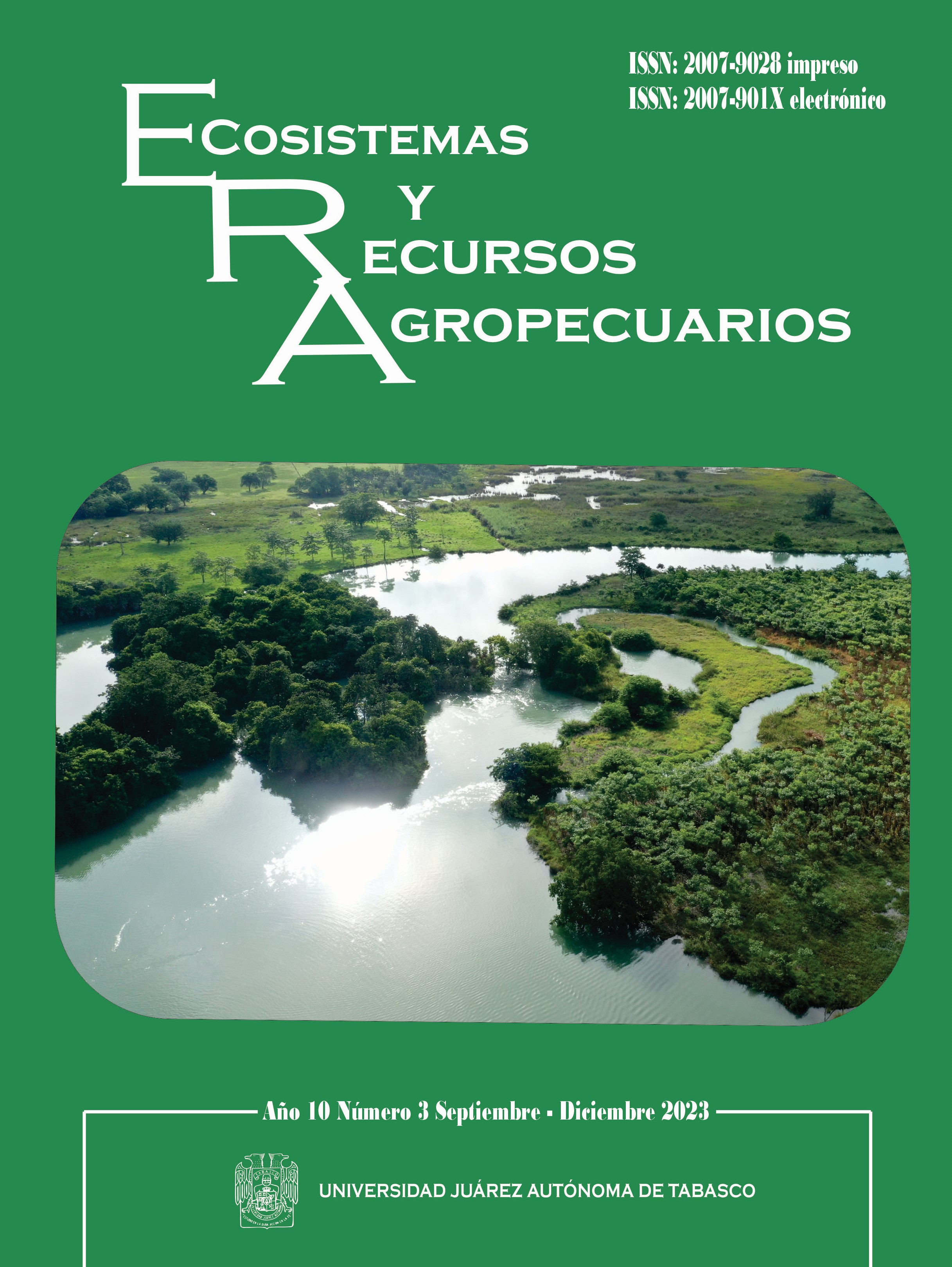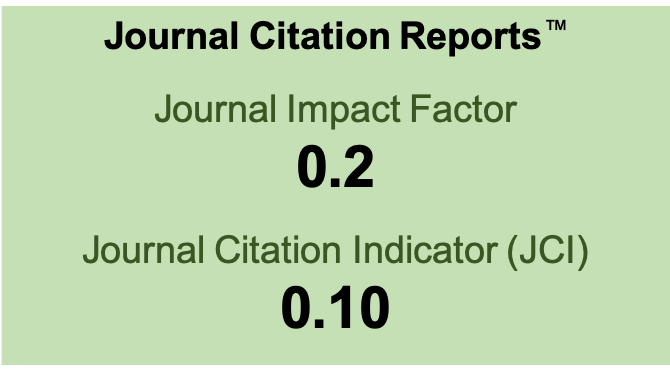Effect of salinity on growth, of juvenile dormitator latifrons (Richardson, 1844)
DOI:
https://doi.org/10.19136/era.a10n3.3754Keywords:
Native fish, euryhaline, productive performance, hematology, blood chemistryAbstract
Dormitator latifrons, a native euryhaline species belonging to the family Eleotridae, is distributed from southern California to Peru. This research study is a contribution to evaluate the effect of different salinity concentrations (0, 10, 20 and 33 UPS) on growth, survival, hematology and blood chemistry. The results show statistical difference (P < 0.05) in the treatment at 10 UPS in weight per individual (91.5 ± 7.5 g), final biomass (2286.3 ± 188.3 g) and weight gain (55.5 ± 5.9 g). In the hematological parameters, statistical differences (P < 0.05) were found in the total erythrocyte count (× 106), with the highest value (4.33 ± 0.49) in the 20 UPS treatment and the lowest value (2.77 ± 0.13) in the 0 UPS treatment; survival was greater than 90.7% in all treatments. Finally, it can be concluded that the 10 UPS treatment had a greater influence on the weight (g) of Dormitator latifrons juveniles, and the GP and EA growth rates increased proportionally in the 10 UPS treatment. The results show that salinity influences the growth of the organisms despite the fact that Dormitator latifrons is a euryhaline organism. It was observed that the highest growth occurred at a salinity of 10 UPS.
Downloads
References
Alaye-Rahy N, Morales-Palacios JJ (2013) Parámetros hematológicos y células sanguíneas de organismos ju- veniles del pescado blanco (Christoma estor estor) cultivados en Páztcuaro, Michoacán, México. Hidro- biológica 23: 340-347.
AOAC (2005) Official methods of analysis. 18th edn. Association of Official Analytical Chemists. Gaithersburg, MD, USA. 684p.
Arredondo JL, Lozano SL (2003) La acuicultura en México. Universidad Autónoma Metropolitana - Iztapalapa. México. 266p.
Basto-Rosales MER, Carrillo-Farnés O, Montoya-Martínez CE, Badillo-Zapata D, Rodríguez-Montes de Oca, GA, Álvarez-González CA (2020) Calidad de la proteína de la carne de Dormitator latifrons (Pisces: Eleotri- dae): argumentos para su uso en comunidades rurales. Revista Ecosistemas y Recursos Agropecuarios 7: e2172. DOI: 10.19136/era.a7n1.2172.
Castro-Rivera R, Aguilar-Benítez G, Hernández-Girón JP (2005) Conversión alimenticia en engordas puras y mixtas de Popoyote (Dormitator latifrons Richardson) en estanques de cemento. Revista AquaTIC 23: 45- 52.
Chang BD (1984) Tolerances to salinity and air exposure of Dormitator latifrons (Pisces: Eleotridae). Revista Biología Tropical 32: 155-157.
DOF (2023) Ley general de pesca y acuacultura sustentables. México. https://www.dof.gob.mx/index_111.php? year=2023&month=02&day=23gsc.tab=0 Fecha de consulta: 20 de septiembre de 2023.
FAO (2022) El estado mundial de la pesca y la acuicultura 2022. Hacia la transformación azul. Roma, FAO. https://doi.org/10.4060/cc0461es. Fecha de consulta: 20 de septiembre de 2023.
García-Gómez A, De la Gándara F, Raja T (2002) Utilización del aceite de clavo, Syzygium aromaticum L. (Merr. y Perry), como anestésico eficaz y económico para labores rutinarias de manipulación de peces marinos cultivados. Boletín del Instituto español oceanografía 18: 21-23.
Hrubec TC, Smith SA (2010) Hematology of fishes. In: Weiss DJ, Wardrop KJ (Eds) Schalm’s veterinary hema- tology. Wiley-Blackwell Publishing. New Jersey. pp: 1994-1003.
Ibrahem MD, Fathi M, Mesalhy S, Abd El-Aty AM (2010) Effect of dietary supplementation of inulin and vitamin C on the growth, hematology, innate immunity, and resistance of Nile tilapia (Oreochromis niloticus). Fish & Shellfish Immunology 29: 241-246.
Larumbe E (2002) Algunos aspectos biológicos de los popoyotes (Dormitator latifrons) en cautiverio. Revista Panorama Acuícola 24-25. http://fis.com/panoramacuicola/noticias/noticia%203.htm. Fecha de consulta: 20 de abril 2023.
Lisboa V, Barcarolli IF, Sampaio LA, Bianchini A (2015) Efecto de la salinidad sobre la supervivencia, el crecimiento y los parámetros bioquímicos en juveniles de lisa de Lebranch Mugil liza (Perciformes: Mugilidae). Ictiología neotropical 13: 447-452.
Loor-Risco O (2000) El Chame - Dormitator latifrons - una opción de vida para las comunidades de escasos re- cursos económicos en la costa ecuatoriana. Publicación de estudios realizados en la provincia del Guayas- Ecuador. https://es.scribd.com/document/229615586/EL-CHAME. Fecha de consulta: 20 de abril de 2023.
Martins CI, Eding EH, Verdegem MCJ, Heinsbroek LTN, Schneider O, Blancheton JP, Roque d’Orbcastel E, Verreth JAJ (2010) New developments in recirculating aquaculture systems in Europe: A perspective on environmental sustainability. Aquacultural Engineering 43: 83-93.
Mena-Herrera A, Sumano-López H, Macías-Zamora R (2002) Efecto de la salinidad en el crecimiento de tilapia híbrida Oreochromis mossambicus (Peters) × Oreochromis niloticus (Linnaeus), cultivadas bajo condi- ciones controladas de laboratorio. Veterinario México 33: 39-48.
Meraj M, Yousuf AR, Bhat FA, Ali MN, Ganai BA, Shahi N, Habiba B, Ganaie HA, Shah NUD, Rahman M, Rather MI (2016) Hematological profiling of Triplophysa marmorata (Heckel 1838) from water bodies of Kashmir HimalayaA Perspective. Journal of Fisheries and Aquatic Science 11: 296- 303.
Neill BO, De Raedemaecker F, Mcgrath D, Brophy D (2011) An experimental investigation of salinity effects on growth, development and condition in the European flounder (Platichthys flesus L.). Journal of Experiemen- tal Marine Biology and Ecology 410: 39-44.
Okolodkov YB, Bastida-Zavala R, Ibáñez LA, Chapman WJ, Suarez-Morales E, Pedroche F (2007) Especies acuáticas no indígenas en México. Ciencia y Mar 32: 29-67.
Piña-Valdez P, Arzola-González JF, Nieves-Soto M, Medina-Jasso MA (2015) Efecto combinado de temperatura y salinidad en el consumo de oxígeno en postlarvas de camarón blanco Litopenaeus vannamei. Boletim do Instituto de Pesca 41: 89-101.
Roberts RJ, Ellis AE (2001) The anatomy and physiology of teleosts. En: Roberts RJ (ed) Fish pathology. 4ta Ed. Wiley-Blacwell. Philadelphia. pp: 1-11.
Romestend B, Halsband E, Bragoni G, Knezevic G, Maric B, Prochow F (1982) Haematological Study of Ery- throcytic Constants in Some Marine and Freshwater Fishes. Institut Scientifique et Technique des Peches Maritimes 46: 147-156.
Ruiz-González LE, Vega-Villasante F, Tintos-Gómez A, Del Rio-Zaragoza OB, Hernández-Rodríguez M, Patiño- Barragán M, Badillo-Zapata D (2020) Some hematology and blood chemistry parameters of the Pacific fat sleeper Dormitator latifrons (Richardson, 1844). Latin American Journal of Aquatic Research 48: 131-135.
Sampaio LA, Bianchini A (2002) Salinity effects and growth of the euryhaline flounder Paralichthys orbignyanus. Journal of Experimental Marine Biology and Ecology 269: 187-196.
Sokal RR, Rohlf FJ (1995) Biometry: the principles and practice of statistics in biological research. 3rd Edn. W.H. Freeman and Co. New York, USA. 887p.
Stoskopf MK (1993) Clinical pathology. In: Stoskopf MK (Ed) Fish medicine. Saunders, Philadelphia, pp.113-131.
Todd EE (1972) Hemoglobin concentration in a new airbreathing fish. Comparative Biochemistry and Physiology Part A: Physiology 42: 569-573.
Vargas R, Grajales J, Ríos Moreno A, Guerra R, Arjona M, Guerra I (2021) Evaluación de parámetros de desem- peño zootécnico y bienestar animal en juveniles de tilapia del nilo en un sistema de recirculación. Revista Investigaciones Agropecuarias 4: 72-88.
Vega-Villasante F, Ruiz-González LE, Chong-Carrillo O, Basto-Rosales MER, Palma-Cancino DJ, Tintos-Gómez A. Montoya-Martínez CE, Kelly-Gutiérrez LD, Guerrero-Galván SR, Ponce-Palafox JT, Zapata A, Musin GE, Badillo-Zapata D (2021) Biology and use of the Pacific fat sleeper Dormitator latifrons (Richardson, 1844): state of the art review. Latin American Journal of Aquatic Research 49: 391-403.
Zapata AA, Vega-Villasante F, Chong-Carrillo O, Vargas-Ceballos MA y Badillo-Zapata D (2019). Efecto de la salinidad sobre la frecuencia ventilatoria branquial de Dormitator latifrons (Richardson, 1984). Ecosistemas y Recursos Agropecuarios 6: 601-607.
Downloads
Published
Issue
Section
License
Copyright (c) 2023 Ecosistemas y Recursos Agropecuarios

This work is licensed under a Creative Commons Attribution-NonCommercial-ShareAlike 4.0 International License.
Aviso de copyright
Los autores que se envían a esta revista aceptan los siguientes términos:
una. Los autores conservan los derechos de autor y garantizan a la revista el derecho a ser la primera publicación del trabajo con una licencia de atribución de Creative Commons que permite a otros compartir el trabajo con un reconocimiento de la autoría del trabajo y la publicación inicial en esta revista.
B. Los autores pueden establecer acuerdos complementarios separados para la distribución no exclusiva de la versión del trabajo publicado en la revista (por ejemplo, en un repositorio institucional o publicarlo en un libro), con un reconocimiento de su publicación inicial en esta revista.
C. Se permite y se anima a los autores a difundir su trabajo electrónicamente (por ejemplo, en repositorios institucionales o en su propio sitio web) antes y durante el proceso de envío, ya que puede conducir a intercambios productivos, así como a una cita más temprana y más extensa del trabajo publicado. (Consulte El efecto del acceso abierto).



